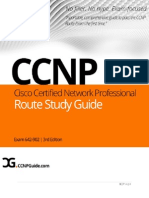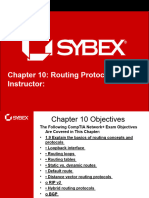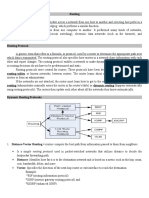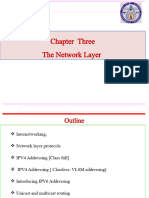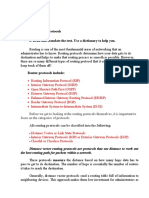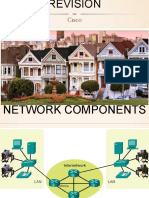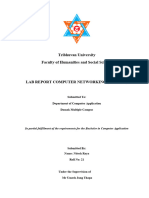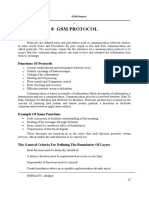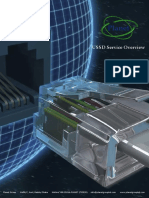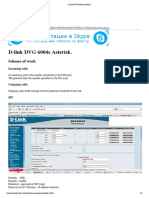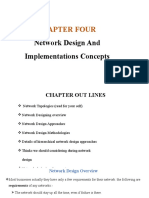ECCI 2105 4/10/2017
Introduction
• The purpose of any routing protocol is to:
– dynamically communicate information about all
Routing Protocols network paths used to reach a destination
– build routing table
– and to select from those paths, the best path to
reach a destination network.
• Some of the most common routing protocols
include IGRP, EIGRP, OSPF, IS-IS and BGP.
ECCI 2105 1 ECCI 2105 2
Distance Vector vs Link State Routing
Classification of Routing Protocols
Protocols
• There are two main classification of routing • "Distance Vector" and "Link State" are terms used
to describe routing protocols which are used by
protocols: routers to forward packets between networks.
– Interior vs Exterior routing protocols • The terms distance vector and link state are used
– Link state vs distance vector routing protocols to group routing protocols into two broad
categories based on whether the routing
protocol:
– selects the best routing path based on a distance
metric (the distance) and an interface (the vector),
– or selects the best routing path by calculating the
state of each link in a path and finding the path that
has the lowest total metric to reach the destination.
ECCI 2105 3 ECCI 2105 4
Distance Vector Routing Example: Routers Exchanging Routing
Initialization Information
ECCI 2105 5 ECCI 2105 6
1
�ECCI 2105 4/10/2017
Routers Exchanging Routing Routers Exchanging Routing
Information Information
ECCI 2105 7 ECCI 2105 8
Convergence B’s Routing Table
ECCI 2105 9 ECCI 2105 10
Distance Vector Routing Protocol Distance Vector Routing Protocol
• Distance: Distance is the cost of reaching a destination, usually
based on the number of hosts the path passes through, or the total • Common distance vector routing protocols
of all the administrative metrics assigned to the links in the path. include:
• Vector: From the standpoint of routing protocols, the vector is the
interface traffic will be forwarded out in order to reach a given – Appletalk RTMP
destination network along a route or path selected by the routing
protocol as the best path to the destination network. – IPX RIP
• Distance vector protocols use a distance calculation plus an
outgoing network interface (a vector) to choose the best path to a – IP RIP
destination network.
• The network protocol (IPX, SPX, IP, Appletalk, DECnet etc.) will
– IGRP
forward data using the best paths selected.
ECCI 2105 11 ECCI 2105 12
2
�ECCI 2105 4/10/2017
A Comparison: Link State vs. Distance
Link State Routing Protocol Vector
• Link State protocols track the status and connection type of each • See Fig. below. If all routers were running a
link and produces a calculated metric based on these and other
factors, including some set by the network administrator. Distance Vector protocol, the path or 'route'
• Link state protocols know whether a link is up or down and how fast chosen would be from A B directly over the
it is (bandwidth and delay) and calculates a cost to 'get there'.
• Link State protocols will take a path which has more hops, but that ISDN serial link, even though that link is about
uses a faster medium over a path using a slower medium with
fewer hops. 10 times slower than the indirect route from A
• Because of their awareness of media types and other factors, link C D B.
state protocols require more processing power (more circuit logic in
the case of ASICs) and memory. Distance vector algorithms being • A Link state protocol would choose the A C D
simpler require simpler hardware.
B path because it's using a faster medium (100
Mb ethernet).
ECCI 2105 13 ECCI 2105 14
A Comparison: Link State vs. Distance
Vector Interior Gateway Routing Protocols
• Interior routing protocol designed for networks that are controlled
by a single organization.
• These dynamic routing protocols keep track of paths used to move
data from one end system to another inside a network or set
of networks that you administrate (all of the networks you manage
combined are usually just one Autonomous System).
• IGP's are how you get all the networks communicating with each
other.
• IGP's fall into two categories:
– Distance Vector Protocols: Routing Information Protocol (RIP), Interior
Gateway Routing Protocol (IGRP), Enhanced Interior Gateway Routing
Protocol (EIGRP).
– Link State Protocols: Open Shortest Path First (OSPF), Intermediate
System to Intermediate System (IS-IS)
ECCI 2105 15 ECCI 2105 16
Exterior Routing Protocols Dynamic Vs Static Routing
• Exterior routing protocol should isolate the autonomous system • Routing tables can contain directly connected, manually
governed by a different administration.
configured static routes and routes learned dynamically using
• The network must have a protocol for communication between
different autonomous systems. a routing protocol.
• Exterior Gateway Protocols handle routing outside an Autonomous • Static routing is when you manually configure a router to send
System and get you from your network, through your Internet
provider's network and onto any other network. traffic for particular destinations in preconfigured directions.
• Exterior routing protocols are designed for use between two • Dynamic routing is when you use a routing protocol such as
different networks that are controlled by two different OSPF, ISIS, EIGRP, and/or BGP to figure out what paths traffic
organizations.
should take.
• Commonly used between ISPs in an ISP or between ISPs within the
company.
• BGP (Border Gateway Protocol)is used by companies with more
than one internet provider to allow them to have redundancy and
load balancing of their data transported to and from the internet.
ECCI 2105 17 ECCI 2105 18










